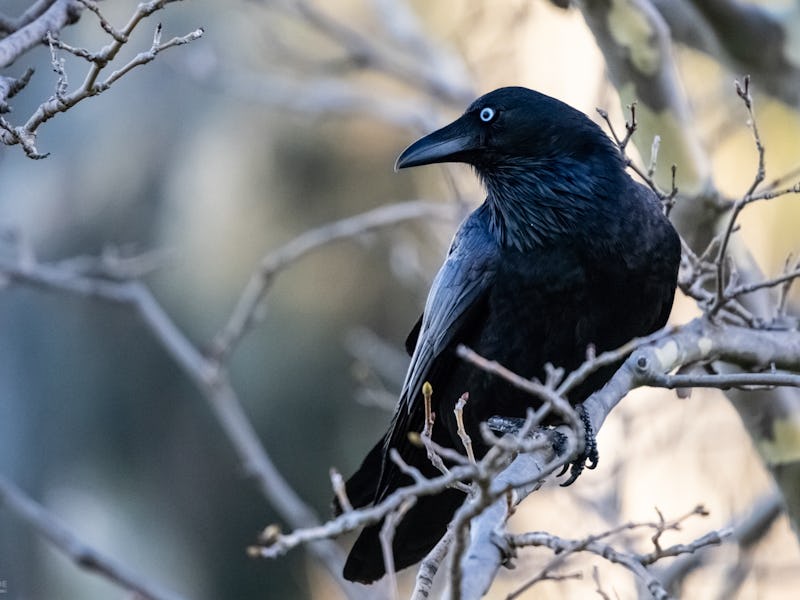New Caledonian Crows Push Limits of Scary-Smart Animals in New Study
Mango the crow puts human IKEA assemblers to shame.

New Caledonian crows are a smart, capable species known for their innovative tool-making skills. Mango the crow, who lives at Oxford University, is a member of this species, but he recently did something no crow or non-human animal had ever done before. In a study released Wednesday in Scientific Reports, researchers revealed that Mango can build a tool from four different parts.
Among animals, the ability to construct a tool out of two parts is already an impressive feat. Humans can do it, and some cases, captive great apes can do so too. Now, according to the study that Mango was a part of, New Caledonian crows can be added to this short list of complex tool-making animals. Four of the eight crows studied in the experiment were capable of creating long-reaching tools out of two short, combinable parts. (Mango was the only bird that made tools out of three or four parts.)
A New Caledonian crow putting a tool to good use.
Alex Kacelnik, Ph.D., a professor of behavioral ecology at the University of Oxford, co-authored this study. Humans, he tells Inverse, start making tools between the ages of five and nine, which is relatively late in life. This suggests that compound tool making is a cognitively difficult step — and makes it all the more impressive that Mango and his friends figured it out.
“A notable problem is that combining pieces to make a new tool without any specific instruction seems to require anticipating the properties of a novel object that does not yet exist,” Kacelnik explains. “It is possible that this can only be done by some form of mental simulation of the outcome.”
Experimental setup in the construction test.
To test the tool-using and tool-making abilities of the crows, Kacelnik and his team presented eight crows caught from the wild with a puzzle box that contained food at the end of a narrow gap. To attain it, the crows would have to use a tool to push the food to the front of the box.
In the first experiment, the crows were given long sticks, and every crow easily figured out how to use the stick to push the food forward. In the second experiment, the scientists switched it up: Instead of a long stick, the crows were given dowels and loose syringes. Neither of these items was long enough on its own, but combined, they could become a far-reaching tool.
Four of the crows figured out how to do it. Those crows made their tools within a few trials, and once they combined the pieces, they used the tools immediately. When the scientists made the task more difficult by supplying three or four combinable parts, Mango was the only one that figured it out.
While New Caledonian crows are well known for making tools in the wild (and it’s possible that they could be doing so without our knowledge), says Kacelnik, this particular ability had never been recorded.
The underlying cognitive process that drives this behavior is, for now, unknown. But the team thinks that the crows’ natural propensity to use tools and their ability to determine which objects can be used as tools certainly help. They hypothesize that the crows may have an ability to innovate using cognitive simulations. In other words, they may play out the potential steps in their brain before settling on a viable solution they can perform.
As for our own history of tool making, anthropologists believe that when ancient people started to make multi-part tools around 300,000 years ago, they took a significant step in brain evolution. That’s because this skill likely co-evolved with planning abilities, complex cognition, and the ability to use language. While this latest study doesn’t imply that the cognitive powers of a crow rival those of humans or apes, it hints that they too have evolved to perform complex tasks with coordination and ease.
Abstract:
The construction of novel compound tools through assemblage of otherwise non-functional elements involves anticipation of the affordances of the tools to be built. Except for few observations in captive great apes, compound tool construction is unknown outside humans, and tool innovation appears late in human ontogeny. We report that habitually tool-using New Caledonian crows (*Corvus moneduloides) can combine objects to construct novel compound tools. We presented 8 naïve crows with combinable elements too short to retrieve food targets. Four crows spontaneously combined elements to make functional tools, and did so conditionally on the position of food. One of them made 3- and 4-piece tools when required. In humans, individual innovation in compound tool construction is often claimed to be evolutionarily and mechanistically related to planning, complex task coordination, executive control, and even language. Our results are not accountable by direct reinforcement learning but corroborate that these crows possess highly flexible abilities that allow them to solve novel problems rapidly. The underlying cognitive processes however remain opaque for now. They probably include the species’ typical propensity to use tools, their ability to judge affordances that make some objects usable as tools, and an ability to innovate perhaps through virtual, cognitive simulations.